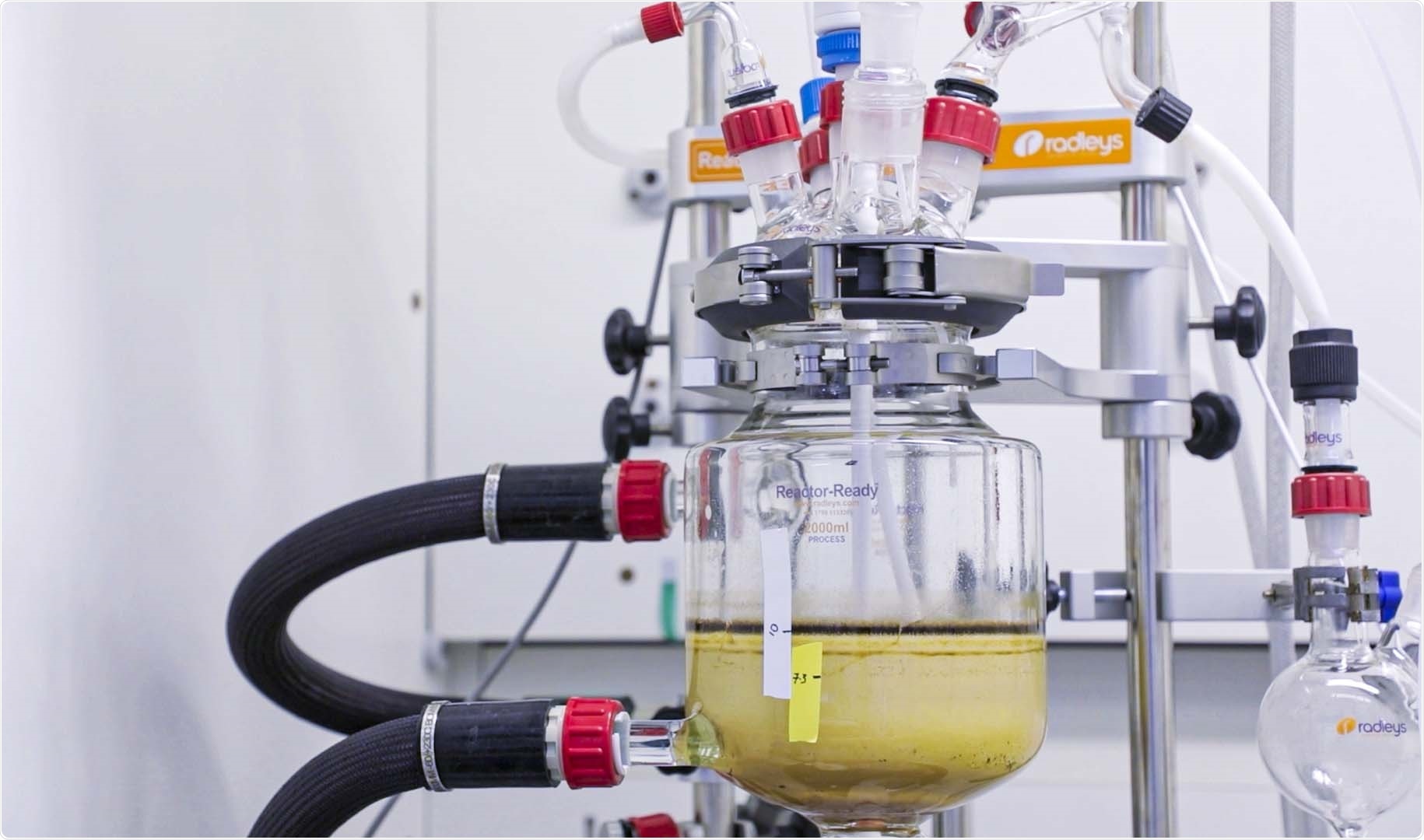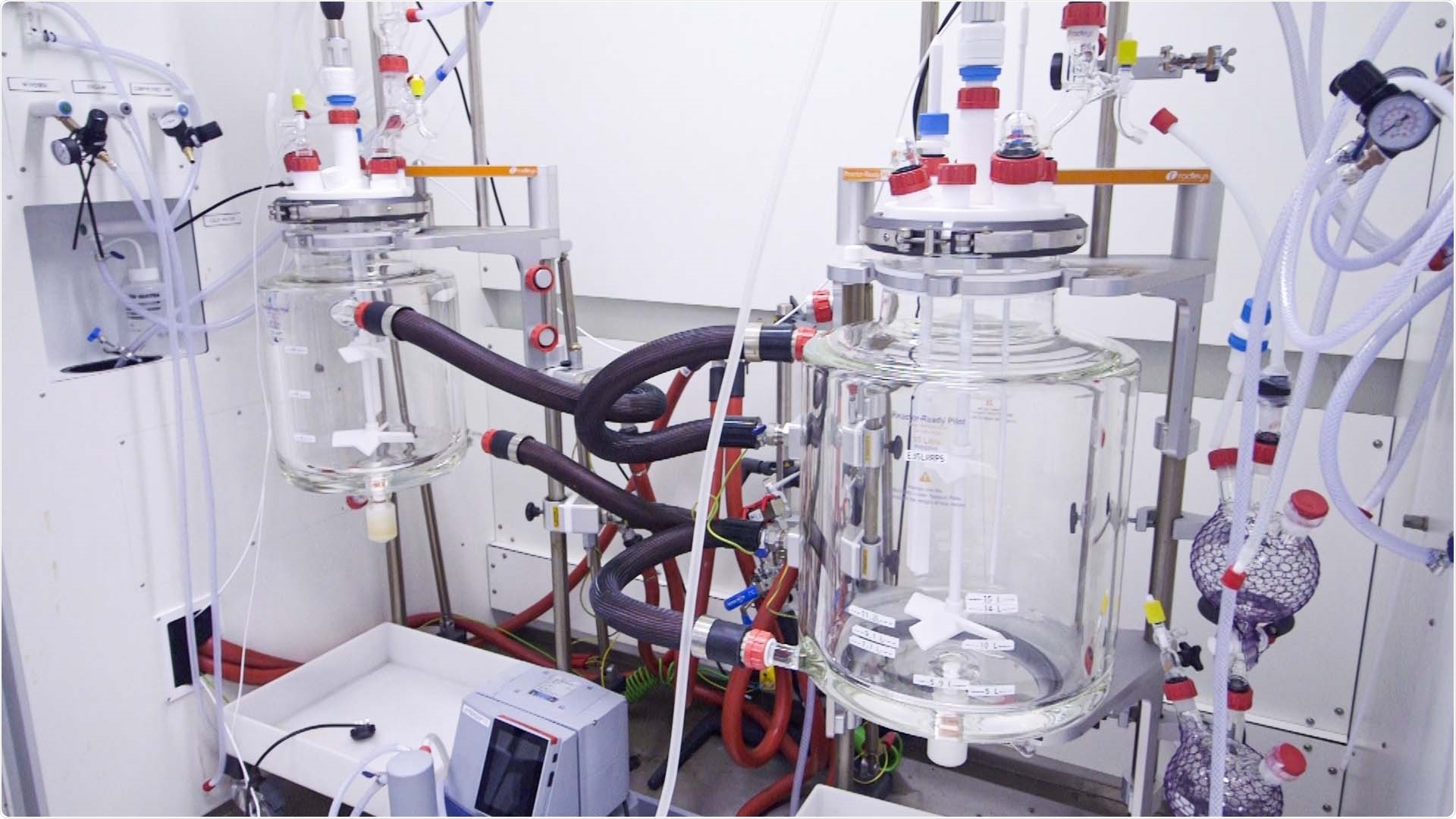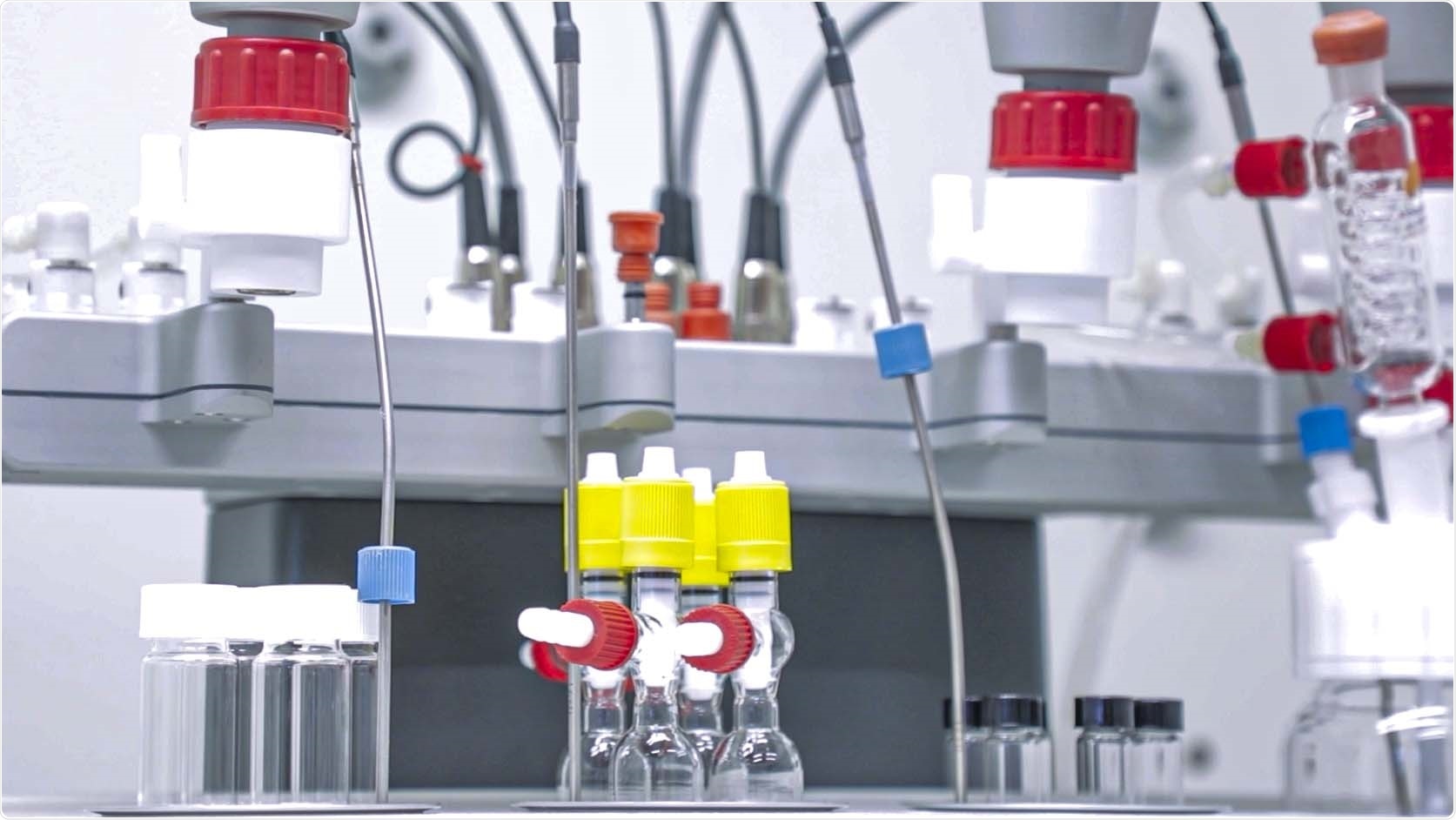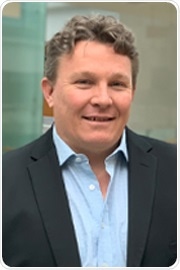Sponsored Content by RadleysReviewed by Alex SmithJan 5 2022
In this interview, News-Medical talks to Andrew Kennedy and Jono West from Sai Life Sciences, about the work they do and how they utilize Radleys equipment in order to understand and overcome chemical synthesis challenges.
Learn how Radleys synthesis equipment is accelerating contract research at SAI Life Sciences
Video Credit: Radleys
Can you introduce yourself and tell us a little bit about your role at Sai Life Sciences?
My name's Jono West. I'm head of safety and scale-up labs at Sai Manchester, Alderley Park.
Can you talk about the facilities that you have here at Sai? What sort of equipment do you use?
We are spread across two buildings at Alderley Park. We've got chemistry and analytical labs. Our analytical labs are fully equipped with all the latest analytical kit. In the chemistry labs, we have a lot of Radley's equipment and we go from a few milliliters scale up to 35 L scale in our scale-up lab.
What are the main challenges your process chemists face in their day-to-day work, especially on the synthesis side?
A lot of our projects we're working to very tight timelines and trying to deliver to our customers on time, in full. Many of the challenges we face are around trying to do the maximum number of reactions that we can efficiently and with good quality results, so that we can use those results to feed into our next set of experiments and deliver to our customers on time.

Image credit: Radleys/Sai Life Sciences
What are the features and benefits you look for in your synthesis equipment for small scale work?
When working on small-scale projects, we're really focusing on parallel experimentation. What we want is equipment that is flexible, easy to use, produces good quality results and allows us to work as efficiently as possible.
When your process cameras are scaling up from gram to kilogram scale, what are the challenges they face and what do they look for in the equipment that they use?
When we're working on a larger scale, we want to use equipment that's representative of what we'll be using on an even larger scale. Reactor-Ready and Reactor-Ready Pilot platforms allow us to use vessels that mimic those in our pilot and manufacturing plants. They also have great data logging capabilities and the flexibility to switch between vessels on that platform in under 30 minutes.
When we're moving from Reactor-Ready into Reactor-Ready Pilot, one of the things that's great is that it looks exactly the same to the users. So, when they come into our scale-up lab and they're using a 35 L vessel, it's the same controls and the same way of operating that they're used to in the normal lab. Our colleagues in our process research labs over in India, have exactly the same equipment, which works exactly the same as what we have in Manchester. So that means when we are transferring processes over to them, or they're bringing processes over to us, we're talking exactly the same language and using the same equipment. This is effectively an efficient technology transfer.

Image credit: Radleys/Sai Life Sciences
What would your team miss the most about that equipment if you had to work in a different way?
If we didn't have Radleys equipment, I think one of the things we'd miss is the technical support and after-sales service. Whenever we have a query or an issue with the equipment, Radleys are always on hand to help, answering our questions and keeping our business on track.
What's the main thing that your customers are looking for when they come to you with projects, and how does Radleys' equipment help you deliver on that?
Our customers are looking for the right material at the right time and of the right purity. Radleys kit helps us do that because it is reliable. We have great service if something goes wrong and we need it fixed. What our customers also want is the intellectual property behind that manufacturing process. Radley's equipment gives us that data logging capability so that we can give them a summary of what's happened, which they can then take forward.
What does that mean for the business in terms of how it helps you to deliver on projects?
As a business, it means that we are competitive and we can deliver the projects that our customers need, in the fastest time possible.
Can you just introduce yourself, tell us about your role here at Sai Life Sciences?
I'm Andrew Kennedy. I'm Site Head at Sai Life Sciences, Manchester, based at Alderley Park. I joined the company two years ago, I was the first UK employee, and with a couple of other colleagues, we were tasked with setting up the new labs, recruiting staff and buying all the new equipment. We are now in a place where there are 60 staff members across about 20,000 square foot of lab space. We have been working on projects for approximately the last 18 months.
What are the main goals of the company?
Sai is a contract development and manufacturing organization. We work with pharma companies, biotechs, to help deliver their drug substances, develop packages and manufacture commercial quantities for them. Here at Manchester, we are very much focused on the development side. We do non-GMP manufacture here, but our site is set up as a process research and development centre of excellence, where we design processes and start to think about the scale-up of those processes.
That's the unique selling point here at Manchester, but Sai as an overall company, delivers services across the whole project life cycle, from discovery all the way through to launch.
What makes Sai unique compared to other CRO/CDMOs?
Sai Life Sciences is fairly unique in the sense that we have operations here in the UK and in India. In India, the main focus is discovery, development and manufacture, whereas here, we focus on the development side.
What's unique is that we can work on processes here in the UK, at the site here at Alderley Park, and we can then tech transfer those processes over to India, to benefit from that low-cost manufacturing option while also giving our clients the excellence in process R&D here in the UK.
Why do pharmaceutical companies use CDMOs like Sai and what do they look for?
Over the past 10 years, pharmaceutical companies have started to outsource a lot more work. They've reduced their footprints internally, and have started to contract that work out to companies like ourselves.
Smaller biotechs don't have the internal capability, so they also need that support. Sai is always there to help those companies develop their projects, and working with pharmaceutical companies and biotechs is very different. Obviously, pharmaceutical companies have a lot of their own internal experience, whereas for biotechs, you may actually be helping to drive their development for them. Sai is able to help those different types of customers through their journey of drug development.

Image credit: Radleys/Sai Life Sciences
Can you talk about the facilities that you have here at Sai and what sort of equipment your chemists use?
As previously mentioned, we've set ourselves up as a process research and development centre of excellence. We're very much focused on route scouting, process development and then small scale-up. We have the equipment to screen reactions on a small scale and then slowly move the development into slightly larger scales. The maximum scale we can go to here is 35 L, so we span that sort of 1 ml vial to the 35 L range.
As soon as projects need larger volumes than this, we then transfer those processes over to our sites in India, where we can operate on the pilot-scale or into commercial manufacturing. The equipment here that we have from a process perspective, allows us to do that. We're also well supported from the analytical side with all of the in-process analyses done largely by the chemists, using LC/MS, GC/MS, NMR, and then we have an analytical department that also assists us in releasing those products to the customers.
What are the main challenges that your bench and process chemists face in their day-to-day work specifically on the synthesis side?
What we're finding with a lot of our customers, is that time is critical for any project. They want the delivery yesterday! We really are limited in terms of the amount of time we can spend on process development, route scouting and the scale-up. So as a chemist, we need to be able to operate in a parallel fashion. For most of our projects, we need to operate parallel reaction screening experimentation, using design of experiments to try and get to the answers a lot quicker than we would've done by traditional means.
This means that we can move forward through those projects a lot quicker than we would've done previously, and that is important for a customer. They don't want to spend a long time on process development before they actually achieve material scale-up.
From a small-scale perspective, that is the biggest challenge where we're looking to get those key answers as quickly as we can using parallel experimentation tools.
As we then move into scale-up, what the customer is looking for is speed, but also quality. We need to do the work here to ensure that when we do scale-up, those processes are scaled-up efficiently. We are aiming to not repeat or rework batches.
As we start to increase the scale of our operation here in Manchester, we need to try and learn about those processes to ensure that that future scale-up is not delayed and that the delivery of the material is also on time.
When undertaking small-scale development projects for your clients, what are the features or benefits that you look for in the synthesis equipment that you use?
When we set up the lab, we've largely orientated ourselves with the Radleys equipment, such as the Radleys Carousels and the Radleys Mya 4, which really helps us in terms of designing those parallel experiments early on in the processes. Whether we're screening for alternative routes of synthesis or looking to optimize process conditions, the Radleys Carousels give us that option of 12 places, 12 different test tubes to operate at a single temperature.

Image credit: Radleys/Sai Life Sciences
The Mya 4 adds the complexity of being able to screen multiple reactions at different temperatures. The beauty of the Mya 4 from our chemists’ perspective, is that it can operate in a number of different modes and screen up to 32 reactions across four different temperatures in small vials which is really helpful at the very start of a project. As we start to scale up, having the ability to run four experiments at four different temperatures with overhead stirring is really important because it starts to give us a feel for how those processes will scale up.
That's also important when doing heterogeneous reactions and crystallization because operating those in a magnetic stir environment is not normally that process-relevant. So, it's important to be able to start to move into equipment that starts to resemble a plant vessel as soon as possible, and that's where the Mya 4 really adds value.
When you process, do you go to that scale-up process from grams up to kilograms? What are the challenges they face at that point? What do you look for in the equipment that you use at that stage?
Once we've completed those screening experiments, we then look to start scaling up the processes, and it's important that we start to move into equipment that starts to resemble our scale-up equipment. So again, we focus mainly on the Radleys Reactor-Ready’s to be able to help us do that. They have the capability of programming reactions and can implement reaction ramps and program additions. They give us the ability to map the process parameter data from those processes. It is really important to provide our scale-up colleagues with that information as we start to scale up the chemistry.
The Reactor-Ready’s are very versatile in the sense that you can operate from anything from 250 ml up to 5 L, and that gives our chemists a lot of flexibility in terms of the scale they operate. Sometimes we're short on material and may not have enough material to run large batches.
The AVA software is also really helpful because it allows us to program the chemistry, to be able to operate those chemistries in the Reactor-Ready and it gathers all of the relevant process data, which actually helps us to understand a little bit about the process safety and start to think about how do we need to design our process as we move into larger vessels. Once we've done it on that Reactor-Ready scale, we then look to move into our Reactor-Ready Pilot, assuming a customer wants a larger delivery.
Radleys pilot-scale reactors go from 5 to 35 L and that's a really nice scale to be able to deliver up to a kilo or two for our customers. Our labs in Manchester are currently non-GMP, so that first pre-clinical delivery is possible within that scale of vessel. As they are very similar in design to the lab version of the Reactor-Ready, it means that process transfer is fairly seamless, and we can again, gather all of the relevant process data using those pilot Reactor-Ready equipment, which we can then pass on to our process engineering teams, ready for tech transfer into a pilot plant or for manufacturing over in India.
How would you say Sai benefits from the deep partnership you have with Radleys?
When we set up the labs, we took the view that we wanted to stick with a few key suppliers for various different bits of equipment, purely because if you can develop a bit of a relationship with that company, you can get access to training tools, to webinars. You can also get a quick turnaround on repairs and maintenance. If you're working with multiple suppliers, it can get quite difficult to arrange, and because we were quite small at the start, it was really important for us to focus on one supplier.
I had had previous experience with Radleys with my former organization at GlaxoSmithKline, as had my colleague Jono and we felt that having that close relationship with a single company for quite a large amount of our process equipment was quite important.

Image credit: Radleys/Sai Life Sciences
That mindset has certainly developed as we've grown in the last two years. We've increased the number of Mya 4s, Reactor-Ready’s etc. to accommodate the increase in the number of chemists, and having that close relationship with Radleys has been really helpful, as they helped ensure that we got that equipment on time so that we were not delaying the start-up of our labs, etc.
What does the future of CDMOs, like Sai Life Sciences, look like over the next few years?
What we're seeing from quite a lot of the large pharma companies, is that they want CDMOs to be largely self-sufficient. They don't want to have to drive the development. They want to leave a project with a CDMO and just come back to them at the end when the project's finished. They don't want to have too much oversight.
Therefore, we need to be really excellent in our delivery. That is the quality of the science that we generate, but also the quality of the delivery in terms of the equipment we use and the materials we then produce. I can see that the CDMO business, certainly in the UK, is going to be independently delivering projects, with maybe some input from those pharma companies.
In contrast to that, I think that for smaller biotechs, this will be a very different game, and there's certainly going to be, I think, a lot more projects where we will ultimately add in a lot more value outside of just process development. We've got a team here with a huge amount of experience across the pharma industry, and we will be able to support some of those biotechs in some of the other packages of work. So for things like Genotox risk assessments, understanding that process scale-up is essential.
We'll ultimately help them plan the future of their drugs. Obviously, pharma companies don't need that support. They have that internally, but the biotechs do sometimes benefit from those additional support mechanisms that we can provide.
About Andrew Kennedy
Vice President and Site Head, Manchester
Acknowledged scientific leader in drug substance process development with >20 years of experience within GSK and its heritage companies following a BSc from Loughborough University, UK.
At GSK led a cross functional drug substance scientific team at GSK to file and launch a new ground-breaking anti-malarial medicine in both the US and Australia.
Joined Sai Life Sciences as Site Head and the first UK employee in November 2019 and set-up the Process Development Centre of Excellence at Alderley Park which now has >60 employees.
About Jono West
Head of Scale-up and Safety
Expert in process development and scale-up to 10/20L, pilot plant and manufacturing scales with 26 years’ experience at GSK. A respected leader of teams, he most recently led a group focussed on developing controlled crystallisations to ensure optimal purity and physical properties of late stage development assets, including file and launch activities. BSc in Chemistry from Newcastle University. Joined Sai Life Sciences in Nov 2019 as Head of Scale-up and Safety.
About Radleys

Radleys, world leaders in innovative productivity tools for chemists. Radleys provide innovative chemistry equipment for safer, cleaner, greener and more productive chemical research.
Radleys have been manufacturing scientific glassware and laboratory instruments for over 50 years and our customers include leading CROs, CDMOs, CMOs and pharmaceutical companies around the world.
- Established in 1966
- Based in Saffron Walden, United Kingdom
- Instrument and glassware manufacturer
- In-house Research and Development facilities
- Distributors in 47 countries
Our areas of expertise are focused on equipment for chemical synthesis, process development, work-up and evaporation.